Daves Old Computers - Apple ][
In 1976, Steve Wozniak and Steve Jobs formed the Apple Computer Company
to sell Wozniak's computer, which they named the "Apple 1". Although it
required the users to provide their own cabinet, power supply, keyboard
and video monitor, it didn't require a seperate terminal as other
computers of the time did. A simple BASIC interpreter could also be
loaded with an optional casette interface. Although it required a fairly
technical user to complete the system and make it usable, about 200 Apple
1's were assembled in Jobs' garage and sold in the first year.
Today Apple Computer Company is known for their
Macintosh computers, and IPOD audio/video
players - but the Apple II is the machine that first brought them success.
Click any photo to view a large high-resolution image.
Apple II
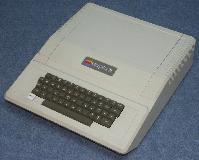 The following year (1977), Apple refined the design, providing a keyboard and
power supply and packaging the machine in a attractive low-profile plastic
cabinet with BASIC in ROM and simple connections for the video monitor and
tape storage. Now anyone who could plug two connectors together could use this
computer. The result, called "Apple II" was one of the most successful early
personal computers, and sold many thousands of units.
The following year (1977), Apple refined the design, providing a keyboard and
power supply and packaging the machine in a attractive low-profile plastic
cabinet with BASIC in ROM and simple connections for the video monitor and
tape storage. Now anyone who could plug two connectors together could use this
computer. The result, called "Apple II" was one of the most successful early
personal computers, and sold many thousands of units.
The Apple II also was the first personal computer to be widely
cloned. The simplicity of Wozniaks design
allowed "anyone" to easily build an Apple II compatible machine. Many clones
were exact copies of the mainboard and ROMs - in some cases, the Apple ][
logo in ROM was not even changed! After winning a landmark court case against
Franklin, Apple agressively persued legal
action against the clone makers, but it was an ongoing battle.
The Apple II was donated by Don Sawyer.
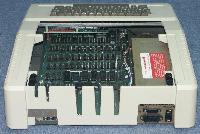 A major feature of the Apple II is 8 expansion slots allowing users to add to
threir machines. The top lifts off to provide easy access, and the rear panel
is designed to provide room for cables to connect to the various peripheral
boards.
A major feature of the Apple II is 8 expansion slots allowing users to add to
threir machines. The top lifts off to provide easy access, and the rear panel
is designed to provide room for cables to connect to the various peripheral
boards.
Additional Views:
Mainboard,
Bottom.
Connectors at the lower left are for video output, and a
cassette tape drive for loading software.
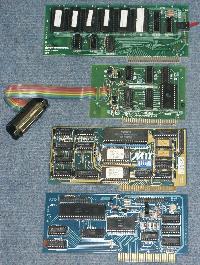 Cards from the Apple II. Top to bottom:
Cards from the Apple II. Top to bottom:
Apple ROM card (*)
Apple serial interface.
Practical Peripherals buffered printer interface.
SSM Apple I/O card.
(*) The Apple II has a fairly limited 4K integer basic in ROM. The ROM card
upgrades the unit to 12K floating point AppleSoft BASIC and an "AutoStart"
ROM which makes the machine go into BASIC or boot a disk (if present)
immediately on power-on. With this upgrade, the Apple II is almost the same as
an Apple II Plus.
Apple II Plus
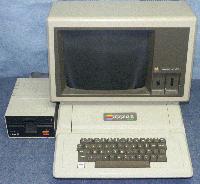 In 1979, the Apple II was slightly updated, becoming the "Apple II Plus". The
hardware was nearly identical to the original Apple 2, however ROM upgrades
gave the machine a more powerful floating point BASIC, an "AutoStart" feature
which made the machine easier to boot up, more displayable colors and a couple
of enhanced graphics modes.
In 1979, the Apple II was slightly updated, becoming the "Apple II Plus". The
hardware was nearly identical to the original Apple 2, however ROM upgrades
gave the machine a more powerful floating point BASIC, an "AutoStart" feature
which made the machine easier to boot up, more displayable colors and a couple
of enhanced graphics modes.
Here we see an Apple Monitor and Apple II
disk drive system, as well as the Main unit.
The Apple II Plus was donated by Jim Fare.
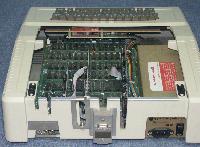 Here we see some installed cards and connectors added to the back panel. Near
the center is a DB-9 connection for an Apple mouse. The
mainboard uses no custom or programmable logic, and
was therefore an easy target for the clone makers. Nearly all Apple II clones
use exactly the same mainboard circuit design as the original Apple units.
Here we see some installed cards and connectors added to the back panel. Near
the center is a DB-9 connection for an Apple mouse. The
mainboard uses no custom or programmable logic, and
was therefore an easy target for the clone makers. Nearly all Apple II clones
use exactly the same mainboard circuit design as the original Apple units.
The ability to exoand and customize the I/O capability of a "turnkey"
system made the Apple II series very popular as an educational tool. Many
schools employed the Apple II and specialized interfaces such as this
fischer technik control lab.
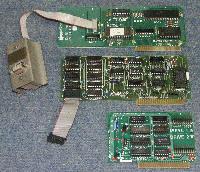 Apple II+ cards. Top to bottom:
Apple II+ cards. Top to bottom:
Apple Mouse Interface.
Apple II Language card (RAM expansion).
Apple Disk controller.
Apple IIe
The IIe was Apple's third release of the Apple II computer, following
the II and the II+. The IIe featured a completely redesigned main board,
using fewer components. It had more RAM and ROM than earlier designs, as
well as on-board 80 column video, and lower-case support.
The IIe is considered to be the most successful of all of the Apple II
computers, and holds the record for sales volume and years in production.
Apple2Es were donated by Kirk Russel, Mike Kenzie and Gordon Dunfield.
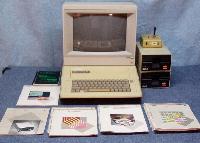 Here is the Apple IIe, complete with an Apple IIe color monitor. To the right
are two AppleII disk drives, and a joystick.
Here is the Apple IIe, complete with an Apple IIe color monitor. To the right
are two AppleII disk drives, and a joystick.
 The Apple IIe main unit.
The Apple IIe main unit.
The familier "wedge
shape" is pretty much unchanged from the very first Apple II.
 Rear view: One area where the IIe was a "step back" from previous designs,
was in the back panel. Earlier Apple II computers had vertical slots for
cable entry which were accessable from the top. The IIe replaced these with
"connector holes", which prevented many of the larger cable connectors from
passing through. The section between the two leftmost holes of this unit
were bent by a previous owner in order to install a large joystick connector.
Rear view: One area where the IIe was a "step back" from previous designs,
was in the back panel. Earlier Apple II computers had vertical slots for
cable entry which were accessable from the top. The IIe replaced these with
"connector holes", which prevented many of the larger cable connectors from
passing through. The section between the two leftmost holes of this unit
were bent by a previous owner in order to install a large joystick connector.
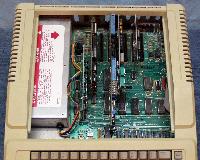 Here is an interior view, showing the installed cards.
Here is an interior view, showing the installed cards.
The
main board, while considerably smaller than
it's predecessors, provides more features than earlier units.
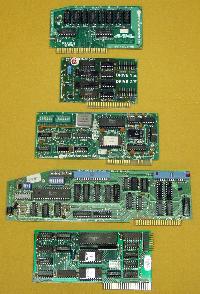 Apple IIe cards. Top to bottom:
Apple IIe cards. Top to bottom:
Apple IIe memory expansion.
Apple Disk controller.
Apple Super Serial.
Issac data collection box interface.
The bottom card are unknown, and unmarked, but carries an RCA 1802 processor.
I have been told that it is a buffered printer interface.
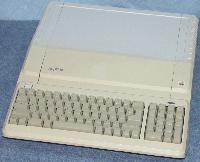 The Apple IIe Platinum is the last Apple II. It is essentially the same
Apple IIe, but with an enhanced keyboard, different logo, and a new lighter
"platinum" case color (in this sample, the forward part of the case has
yellowed a bit, however the back portion is the original color).
The Apple IIe Platinum is the last Apple II. It is essentially the same
Apple IIe, but with an enhanced keyboard, different logo, and a new lighter
"platinum" case color (in this sample, the forward part of the case has
yellowed a bit, however the back portion is the original color).
Apple IIGS
In 1986, Steve Wozniak did a complete redesign of the Apple II computer.
Intended to compete with the likes of the Atari ST and Amiga offerings, the
IIGS was in many ways a completely new 16 bit machine. The "GS" stands for
"Graphics/Sound", and the machine boasts considerable improvements to both,
as well as a faster more powerful 16-bit processor (with an 8-bit 6502
compatibility mode), and a new memory slot
which could accomodate RAM expansion cards up to 8MB. In spite of all of these
changes, it retains good compatibility with the original AppleII when operating
in 8-bit mode.
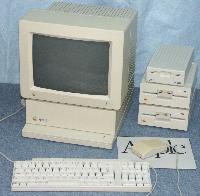 The Apple IIGS - This is the only AppleII to use the ADB (Apple Desktip Bus),
and feature a mouse as standard equipment - in fact, the Keyboard and Mouse
are the same ones used on the Apple Macintosh.
The Apple IIGS - This is the only AppleII to use the ADB (Apple Desktip Bus),
and feature a mouse as standard equipment - in fact, the Keyboard and Mouse
are the same ones used on the Apple Macintosh.
Views: Back, Inside
Apple IIc
The IIc was Apple's first compact Apple II computer. This was
essentially an Apple IIe with built in disk drive and a new ROM in a
compact enclosure. Unlike the other members of the Apple II line, this
machine did NOT provide expansion slots.
An AppleIIc was donated by Mike Kenzie.
 The complete Apple IIc system, which consists of the
main unit, and a separate matching monitor.
The complete Apple IIc system, which consists of the
main unit, and a separate matching monitor.
Right side: Note 5.25" disk drive.
Left side: Note volume control and headphone jack
Bottom view
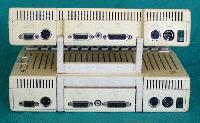 Rear view: Note the carry handle could be folded up into the back
panel, or down to provide a read stand.
Rear view: Note the carry handle could be folded up into the back
panel, or down to provide a read stand.
Left to right: Joystick/Mouse, Serial#2/modem, RGB video, Composite video,
External diskette, Serial#1/printer, power input, power switch.
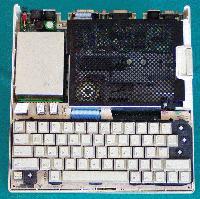 The Apple IIc with the cover removed. Silver box at upper left is
the internal power converter. At the upper right is the built in
diskette drive, and along the bottom is the keyboard.
The Apple IIc with the cover removed. Silver box at upper left is
the internal power converter. At the upper right is the built in
diskette drive, and along the bottom is the keyboard.
With
the keyboard, power supply and disk removed, we can see the Apple IIc
main board.
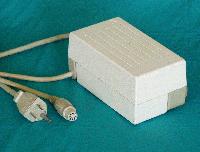 This is the external power supply. This provides 15vac which is
further processed by the internal converter into the various DC
voltages required by the logic components.
This is the external power supply. This provides 15vac which is
further processed by the internal converter into the various DC
voltages required by the logic components.
 Here are three Apple II diskette drives.
Here are three Apple II diskette drives.
AppleII 1979 Advertisement: How to Buy
The Apple-II System Description - Byte May77 (1M ZipJPG)
An Apple to Byte - Byte Mar78 (1.6M PDF)
Apples Enhanced Computer the IIe - Byte Feb83 (2.4M PDF)
The AppleIIc Personal Computer - Byte May84 (1.4M PDF)
6502 CPU Data Sheet (2M PDF)
DOS Apple2 simulator
Windows Apple2 simulator
Apple2 oasis simulator
Back to Old Computers
Copyright 2004-2007 Dave Dunfield.
 The following year (1977), Apple refined the design, providing a keyboard and
power supply and packaging the machine in a attractive low-profile plastic
cabinet with BASIC in ROM and simple connections for the video monitor and
tape storage. Now anyone who could plug two connectors together could use this
computer. The result, called "Apple II" was one of the most successful early
personal computers, and sold many thousands of units.
The following year (1977), Apple refined the design, providing a keyboard and
power supply and packaging the machine in a attractive low-profile plastic
cabinet with BASIC in ROM and simple connections for the video monitor and
tape storage. Now anyone who could plug two connectors together could use this
computer. The result, called "Apple II" was one of the most successful early
personal computers, and sold many thousands of units.
















